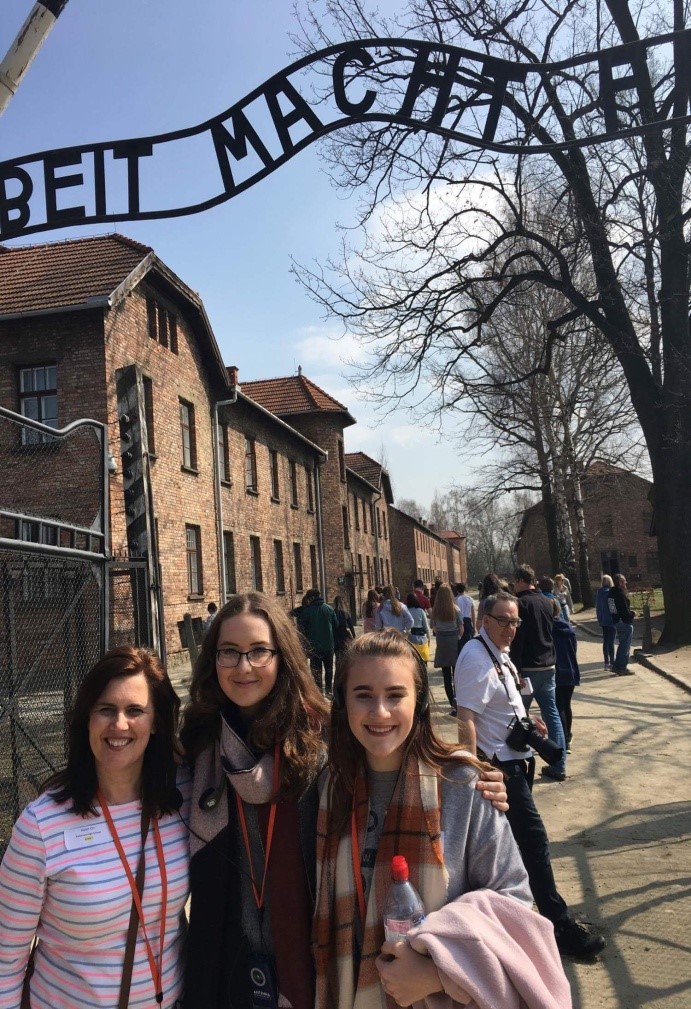Trip to Auschwitz-Birkenau
By Ballyclare High School on 15 June, 2017

As part of the Holocaust Educational Trusts “Lessons from Auschwitz” project in March 2017 myself (yr13), Emma Gault (yr14) & teacher Mrs Orr on behalf of the history department took part in a one day visit to Auschwitz-Birkenau in Poland which was an unforgettable experience.
Prior to the day trip we attended an orientation seminar in the Wellington Park hotel, Belfast. At the seminar we were prepared for our trip, met with pupils from the other schools & had the privilege of hearing from Holocaust survivor – Mala Tribich. Mala was 84 years old and her story had a profound impact on us all. We often hear of statistics regarding the Holocaust, but to hear of Mala’s first hand and personal experience brought home the reality of the event.
Mala was born in 1930 in Poland, much of her early life was spent in a ghetto with a brief period of separation from her parents in order to hide from the Nazis. After working as a slave labourer until 1944 Mala was sent to Ravensbrück concentration camp taking responsibility for her 5 year old cousin – Ann. After a short while they were transported by cattle truck to Bergen-Belsen, conditions were so bad that Mala contracted typhus. Mala stayed here until the time of liberation & throughout her personal account she often spoke of the horror of life in the camps. Mala sadly lost her mother, sister & father during the Holocaust – Notably, her only immediate family member to survive was her brother Ben. Mala’s courage stood out to us all at the orientation seminar.
The day trip itself began with a very early start, meeting at Belfast international airport and flying to Kraków, Poland. When we landed we travelled by coach to the village of Oświęcim. This typical, former Jewish town portrayed to us the normality of life for Jewish people before the Holocaust. This perhaps made our viewings of Auschwitz-Birkenau even more shocking.
Auschwitz-Birkenau was built as a death camp but also functioned as a work camp. It is estimated that a shocking 1.2 million lives ended at Auschwitz-Birkenau.
On our arrival, we first visited Auschwitz I. This section of the camp contained large rooms filled with shoes, hair and even children’s clothing taken from those who suffered the mass genocide. At Auschwitz I we also saw the famous entrance gate with the writing “Arbeit macht frei” which means “Work sets you free” and went inside a gas chamber. We found the personal items extremely hard to view and the tour of Auschwitz I evoked emotions in many of us.
Next, we travelled 3km via coach to Birkenau. Birkenau began to be constructed in March 1941 and acted as a supplement to Auschwitz I, however it soon became the main extermination centre. The grand scale of Birkenau made me realise how many individuals has suffered there. Throughout our visit we saw the railway line which brought many prisoners unknowingly to the site of their death & also saw the crematoria which the Nazis had attempted to destroy prior to liberation of the camps by allied forces.
As our visit to Birkenau came to a close, we took part in a short memorial service on steps beside the crematoria conducted by Rabbi Marcus. This service was memorable and provided us with some valuable time to reflect on what we had witnessed. Following the service, we left Birkenau and travelled to the airport in order to fly back home to Belfast.
In the week following our visit we attended a follow up seminar and exchanged ideas regarding our “next steps” part of the programme. Emma and I decided to share our visit with some Yr.10 pupils of Ballyclare High, giving them an insight into the trip & ensuring the Holocaust is not forgotten.
Overall the lessons from Auschwitz project was an emotional, once in a lifetime experience which I am extremely proud to have been part of. Based on the principle that “hearing is not like seeing” it provided us with the opportunity to gain a first hand experience of what we had only read about in textbooks and on our return, share this valuable experience with others.
Sarah Bridle & Emma Gault
